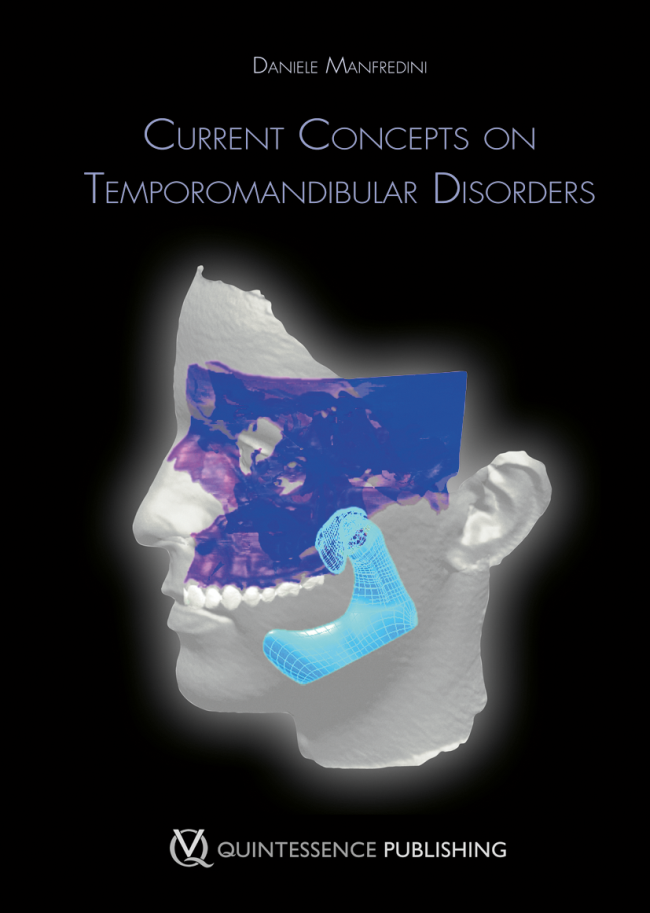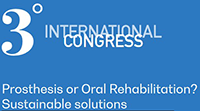Journal of Craniomandibular Function, 3/2023
ScienceSeiten: 233-272, Sprache: Englisch, DeutschDelcanho, Robert / Val, Matteo / Guarda Nardini, Luca / Manfredini, DanieleAktuelle EvidenzJournal of Oral & Facial Pain and Headache, 2/2023
DOI: doi: 10.11607/ofph.3290Seiten: 81-90, Sprache: EnglischGreene, Charles S / Manfredini, DanieleAims: To describe how some management practices in the field of orofacial musculoskeletal disorders (also described as temporomandibular disorders [TMDs]) are based on concepts about occlusal relationships, condyle positions, or functional guidance; for some patients, these procedures may be producing successful outcomes in terms of symptom reduction, but in many cases, they can be examples of unnecessary overtreatment.
Methods: The authors discuss the negative consequences of this type of overtreatment for both doctors and patients, as well as the impact on the dental profession itself. Special focus is given to trying to move the dental profession away from the old mechanical paradigms for treating TMDs and forward to the more modern (and generally more conservative) medically based approaches, with emphasis on the biopsychosocial model.
Results: The clinical implications of such a discussion are apparent. For example, it can be argued that the routine use of Phase II dental or surgical treatments for managing most orofacial pain cases represents overtreatment, which cannot be defended on the grounds of symptom improvement (ie, "successful" outcomes) alone. Similarly, there is enough clinical evidence to conclude that complex biomechanical approaches focusing on the search for an ideal specific condylar or neuromuscular position for the management of orofacial musculoskeletal disorders are not needed to produce a positive clinical result that is stable over time.
Conclusion: Typically, overtreatment successes cannot be easily perceived by the patients or the treating dentists because the patients are satisfied and the dentists feel good about those outcomes. However, neither party knows whether an excessive amount of treatment has been provided. Therefore, both the practical and ethical aspects of this discussion about proper treatment vs overtreatment deserve attention.
Schlagwörter: orofacial musculoskeletal disorders, overtreatment, success, temporomandibular disorders, temporomandibular joint
Journal of Craniomandibular Function, 1/2022
ScienceSeiten: 25-34, Sprache: Englisch, DeutschManfredini, Daniele / Lombardo, Luca / Visentin, Alessandra / Arreghini, Angela / Siciliani, GiuseppeEine elektromyografische UntersuchungZiel: Ziel war es, in einer Gruppe gesunder junger Erwachsener anhand häuslicher EMG-/EKG-Aufzeichnungen mit einem tragbaren Gerät den Zusammenhang zwischen der Zahnabnutzung und der Schlafaktivität des Musculus masseter (SAMM) zu untersuchen.
Material und Methode: Insgesamt 41 gesunde Freiwillige (23 Frauen und 18 Männer im Durchschnittsalter von 28,8 Jahren, Spannweite 25 bis 40 Jahre) mit natürlichen Zähnen in gutem Zustand führten zu Hause zwei Nächte lang Aufzeichnungen mit einem tragbaren Gerät durch, dass die simultane Erfassung von EMG-Signalen beider Mm. masseteres sowie der Herzfrequenz ermöglicht. Hiermit wurde die Anzahl der Schlafbruxismus-(SB-)Episoden pro Stunde, die Anzahl phasischer, tonischer und gemischter SAMM-Ereignisse pro Stunde und die Gesamtanzahl von SAMM-Ereignissen pro Nacht ermittelt. Zudem wurde bei allen Probanden an digitalen Modellen mithilfe einer sechsstufigen Skala die Zahnabnutzung bewertet. Schließlich wurden mithilfe des Pearson-Tests Korrelationen zwischen den SAMM-Parametern und der Zahnabnutzung geprüft.
Ergebnisse: Der SB-Index lag im Durchschnitt bei 4,5 ± 2,6, die Gesamtanzahl der Masseterkontraktionen im Schlaf bei 97,2 ± 55,2. Von diesen Kontraktionen waren fast 60 % phasischer Natur. Die durchschnittliche Zahnabnutzung betrug 1,5 ± 0,7, wobei die Eckzähne und Unterkiefer-Schneidezähne die stärkste Abnutzung zeigten. Keiner der gepaarten Tests ergab eine signifikante Korrelation (p-Werte: 0,11 bis 0,69). Die r-Werte bewegten sich im Bereich von 0,064 bis 0,253.
Schlussfolgerung: Die Nullhypothese einer fehlenden Korrelation zwischen Zahnabnutzung und SAMM konnte nicht abgelehnt werden, was bedeutet, dass Zahnabnutzung nicht als Indikator für rezenten SB oder für SAMM fungieren kann. Künftige Studien, in denen die vielschichtige Natur von Zahnabnutzung und der komplizierte natürliche Ablauf von Schlafphänomenen Berücksichtigung finden, sollten das Problem auch auf individueller Ebene weiter untersuchen.
Schlagwörter: Elektromyografie, Kaumuskelaktivität, Schlafbruxismus, Zahnabnutzung
Journal of Oral & Facial Pain and Headache, 1/2022
DOI: 10.11607/ofph.3023Seiten: 6-20b, Sprache: EnglischDelcanho, Robert / Val, Matteo / Nardini, Luca Guarda / Manfredini, Daniele
Aims: To systematically review the scientific literature for evidence concerning the clinical use of botulinum toxin (BTX) for the management of various temporomandibular disorders (TMDs).
Methods: A comprehensive literature search was conducted in the Medline, Web of Science, and Cochrane Library databases to find randomized clinical trials (RCT) published between 2000 and the end of April 2021 investigating the use of BTX to treat TMDs. The selected articles were reviewed and tabulated according to the PICO (patients/problem/population, intervention, comparison, outcome) format.
Results: A total of 24 RCTs were selected. Nine articles used BTX injections to treat myofascial pain, 4 to treat temporomandibular joint (TMJ) articular TMDs, 8 for the management of bruxism, and 3 to treat masseter hypertrophy. A total of 411 patients were treated by injection of BTX. Wide variability was found in the methods of injection and in the doses injected. Many trials concluded superiority of BTX injections over placebo for reducing TMD pain levels and improving maximum mouth opening; however, this was not universal.
Conclusion: There is good scientific evidence to support the use of BTX injections for treatment of masseter hypertrophy and equivocal evidence for myogenous TMDs, but very little for TMJ articular disorders. Studies with improved methodologic design are needed to gain better insight into the utility and effectiveness of BTX injections for treating both myogenous and TMJ articular TMDs and to establish suitable protocols for treating different TMDs.
Schlagwörter: botulinum toxin, bruxism, myofascial, pain, temporomandibular disorders, temporomandibular joint
Journal of Oral & Facial Pain and Headache, 4/2021
DOI: 10.11607/ofph.2917Seiten: 288-296, Sprache: EnglischCanales, Giancarlo De la Torre / Poluha, Rodrigo Lorenzi / Pinzón, Yeidi Natalia Alvarez / Conti, Paulo César Rodrigues / Manfredini, Daniele / Sánchez-Ayala, Alfonso / Rizzatti-Barbosa, Célia MarisaAims: To determine the effects of botulinum toxin type A (BoNT-A) on the psychosocial features of patients with masticatory myofascial pain (MFP).
Methods: A total of 100 female subjects diagnosed with MFP were randomly assigned into five groups (n = 20 each): oral appliance (OA); saline solution (SS); and three groups with different doses of BoNT-A. Chronic pain-related disability and depressive and somatic symptoms were evaluated with the Research Diagnostic Criteria for Temporomandibular Disorders (RDC/TMD) Axis II instruments at baseline and after 6 months of treatment. Differences in treatment effects within and between groups were compared using chi-square test, and Characteristic Pain Intensity (CPI) was compared using two-way ANOVA. A 5% probability level was considered significant in all tests.
Results: Most patients presented low pain-related disability (58%), and 6% presented severely limiting, high pain-related disability. Severe depressive and somatic symptoms were found in 61% and 65% of patients, respectively. In the within-group comparison, BoNT-A and OA significantly improved (P < .001) scores of pain-related disability and depressive and somatic symptoms after 6 months. Only the scores for painrelated disability changed significantly over time in the SS group. In the betweengroup comparison, BoNT-A and OA significantly improved (P < .05) scores of all variables at the final follow-up when compared to the SS group. No significant difference was found between the BoNT-A and OA groups (P > .05) for all assessed variables over time.
Conclusion: BoNT-A was at least as effective as OA in improving pain-related disability and depressive and somatic symptoms in patients with masticatory MFP.
Schlagwörter: botulinum toxin, depression, myofascial pain, psychosocial impairment, temporomandibular disorders
Journal of Oral & Facial Pain and Headache, 2/2021
Seiten: 113-118, Sprache: EnglischGuarda-Nardini, Luca / Meneghini, Maddalena / Zegdene, Sayma / Manfredini, Daniele
Aims: To report the effectiveness of temporomandibular joint (TMJ) arthrocentesis with viscosupplementation for degenerative joint disease (DJD) over a long-term (ie, 10-22 years) follow-up.
Methods: A total of 103 patients aged between 30 and 91 years (13 men and 90 women; mean age 63.7 years) who received a cycle of five arthrocentesis sessions with HA viscosupplementation to manage their symptoms related to TMJ DJD during the time period from 1998 to 2010 were recalled for clinical evaluation. After the treatment cycle, clinical outcomes were assessed based on the following parameters: maximum mouth opening (MO), pain with function (PF), pain at rest (PR), and self-reported chewing efficiency (CE). Data were collected at baseline (T0) and at successive follow-up assessments, after at least 3 months (T1) and 1 year (T2), as per previous publications. Patients who had received treatment at least 10 years prior were then recalled for this study (T3: 10 to 22 years follow-up). Analysis of variance for repeated measures was performed to assess changes over time.
Results: Significant improvement in all clinical parameters was achieved at T1 and was maintained for up to 10 years (T3), with P < .01 for each parameter. At T3, treatment effectiveness was perceived as excellent by 56% and as good by 26.5% of subjects, while 10.7% perceived a moderate improvement, and 6.8% referred a slight improvement or did not have any improvement. Only seven individuals required additional treatments after T2.
Conclusion: These findings suggest that the symptomatic management of TMJ DJD achieved in the short or medium term with a cycle of arthrocentesis and viscosupplementation was effectively maintained in the long term.
Schlagwörter: arthrocentesis, temporomandibular disorders, temporomandibular joint
Journal of Oral & Facial Pain and Headache, 1/2021
Seiten: 17-29, Sprache: EnglischGuarda-Nardini, Luca / De Almeida, Andrè Mariz / Manfredini, DanieleAims: To review randomized clinical trials on arthrocentesis for managing temporomandibular disorders (TMD) and to discuss the clinical implications.
Methods: On March 10, 2019, a systematic search of relevant articles published over the last 20 years was performed in PubMed, as well as in Scopus, the authors’ personal libraries, and the reference lists of included articles. The focus question was: In patients with TMD (P), does TMJ arthrocentesis (I), compared to any control treatment (C), provide positive outcomes (O)? Results/
Conclusion: Thirty papers were included comparing TMJ arthrocentesis to other treatment protocols in patients with disc displacement without reduction and/or closed lock (n = 11), TMJ arthralgia and/or unspecific internal derangements (n = 8), or TMJ osteoarthritis (n = 11). In general, the consistency of the findings was poor because of the heterogenous study designs, and so caution is required when interpreting the meta-analyses. In summary, it can be suggested that TMJ arthrocentesis improves jaw function and reduces pain levels, and the execution of multiple sessions (three to five) is superior to a single session (effect size = 1.82). Comparison studies offer inconsistent findings, with the possible exception of the finding that splints are superior in managing TMJ pain (effect size = 1.36) compared to arthrocentesis, although this conclusion is drawn from very heterogenous studies (I2 = 94%). The additional use of cortisone is not effective for improving outcomes, while hyaluronic acid or platelet-rich plasma positioning may have additional value according to some studies. The type of intervention, the baseline presence of MRI effusion, and the specific Axis I diagnosis do not seem to be important predictors of effectiveness, suggesting that, as in many pain medicine fields, efforts to identify predictors of treatment outcome should focus more on the patient (eg, age, psychosocial impairment) than the disease.
Schlagwörter: arthrocentesis, disc displacement, osteoarthritis, temporomandibular disorders, temporomandibular joint
Journal of Oral & Facial Pain and Headache, 3/2020
Seiten: 206-216, Sprache: EnglischGreene, Charles S. / Manfredini, DanieleWithin the orofacial pain discipline, the most common group of afflictions is temporomandibular disorders (TMD). The pathologic and functional disorders included in this condition closely resemble those that are seen in the orthopedic medicine branch of the medical profession, so it would be expected that the same principles of orthopedic diagnosis and treatment are applied. Traditional orthopedic therapy relies on a "Two Pathway" approach involving conservative and/or surgical treatments. However, over the course of the 20th century, some members of the dental community have created another way of approaching these disorders— referred to in this paper as the "Third Pathway"—based on the assumption that signs and symptoms of TMD are due to a "bad" relationship between the mandible and skull, leading to a variety of irreversible occlusal or surgical corrective treatments. Since no other human joint is discussed in these terms within the orthopedic medicine communities, it has become progressively clear that the Third Pathway is a unique and artificial conceptual creation of the dental profession. However, many clinical studies have utilized the medically oriented conservative/ surgical Two-Pathway model to diagnose and treat TMD within a biopsychosocial model of pain. These studies have shown that TMD comprise another domain of orthopedic illness that requires a medically oriented approach for good outcomes while avoiding the irreversible aspects of the Third Pathway. This review presents historical and current evidence that the Third Pathway is an example of unorthodox medicine that leads to unnecessary overtreatment and further proposes that it is time to abandon this approach as we move forward in the TMD field.
Schlagwörter: dental occlusion, jaw repositioning, orthopedics, temporomandibular disorders, TMD
The International Journal of Prosthodontics, 2/2020
DOI: 10.11607/ijp.5847, PubMed-ID: 32069339Seiten: 155-159, Sprache: EnglischDe la Torre Canales, Giancarlo / Bonjardim, Leonardo Rigoldi / Poluha, Rodrigo Lorenzi / Carvalho Soares, Flávia Fonseca / Guarda-Nardini, Luca / Conti, Paulo Rodrigues / Manfredini, DanielePurpose: To assess the correlation between RDC/TMD Axis I and Axis II diagnoses and whether pain could mediate a possible correlation between these two variables.
Materials and Methods: Data of both RDC/ TMD axes were collected from 737 consecutive patients who sought TMD advice at the University of Padova, Italy. A descriptive analysis was used to report the frequencies of Axis I and II diagnoses, and Spearman test was performed to assess the correlation between the axes. Subsequently, the sample was divided into two groups (painful vs nonpainful TMD). Frequencies were reported using descriptive analysis, and chi-square test was used to compare groups. The painful TMD group was then divided based on the level of painrelated impairment (low = Groups I and II; high = Groups III and IV). Then, frequencies of depression and somatization were reported using descriptive analysis for each disability group, and chi-square test was used to compare groups.
Results: No correlation levels were found between Axis I and any of the Axis II findings (Graded Chronic Pain Scale, depression, and somatization). The painful TMD group presented higher levels of depression and somatization (P .05). Comparisons of depression and somatization frequencies between pain-impairment groups showed a significantly higher prevalence of abnormal scores for the severe painimpairment group.
Conclusion: There is no correlation between specific Axis I and Axis II findings. The presence of pain, independent of the muscle or joint location, is correlated with Axis II findings, and higher levels of pain-related impairment are associated with the most severe scores of depression and somatization.
Journal of Oral & Facial Pain and Headache, 2/2019
Seiten: 199-204, Sprache: EnglischManfredini, Daniele / Lombardo, Luca / Visentin, Alessandra / Arreghini, Angela / Siciliani, GiuseppeAims: To assess the correlation between tooth wear and sleep-time masseter muscle activity (sMMA) in a group of healthy young adults who underwent home electromyographic/electrocardiographic (EMG/ECG) recordings with a portable device.
Methods: A total of 41 healthy volunteers (23 women, 18 men; mean age 28.8 years, range 25 to 40) with good natural dentition underwent a 2-night in-home evaluation with a portable device that allowed a simultaneous sleep-time recording of EMG signals from both masseter muscles and heart rate. The number of sleep bruxism (SB) episodes per sleep hour (SB index), the number of phasic, tonic, and mixed sMMA events per hour, and the total number of sMMA events per night were calculated. All individuals also underwent an assessment of tooth wear on digital casts with the adoption of a six-degree rating scale. Correlations between sMMA variables and tooth wear were assessed using Pearson test. The null hypothesis was that correlation between the two conditions would not be significant.
Results: On average, the SB index was 4.5 ± 2.6, while the total number of sleep-time masseter contractions was 97.2 ± 55.2. Of those contractions, almost 60% were phasic. Average tooth wear was 1.5 ± 0.7, with the canines and mandibular incisors showing the highest wear scores. For all pairwise analyses, correlation values were not significant (P values .11 to .69), with r values ranging from 0.064 to 0.253.
Conclusion: The null hypothesis of an absence of correlation between tooth wear and sMMA could not be rejected, implying that tooth wear cannot be used as an indicator of ongoing SB or sMMA. Future studies taking into account the multifaceted nature of tooth wear and the complex natural course of sleep phenomena are encouraged to investigate the issue further, at the individual level.
Schlagwörter: electromyography, masticatory muscles activity, sleep bruxism, tooth wear









